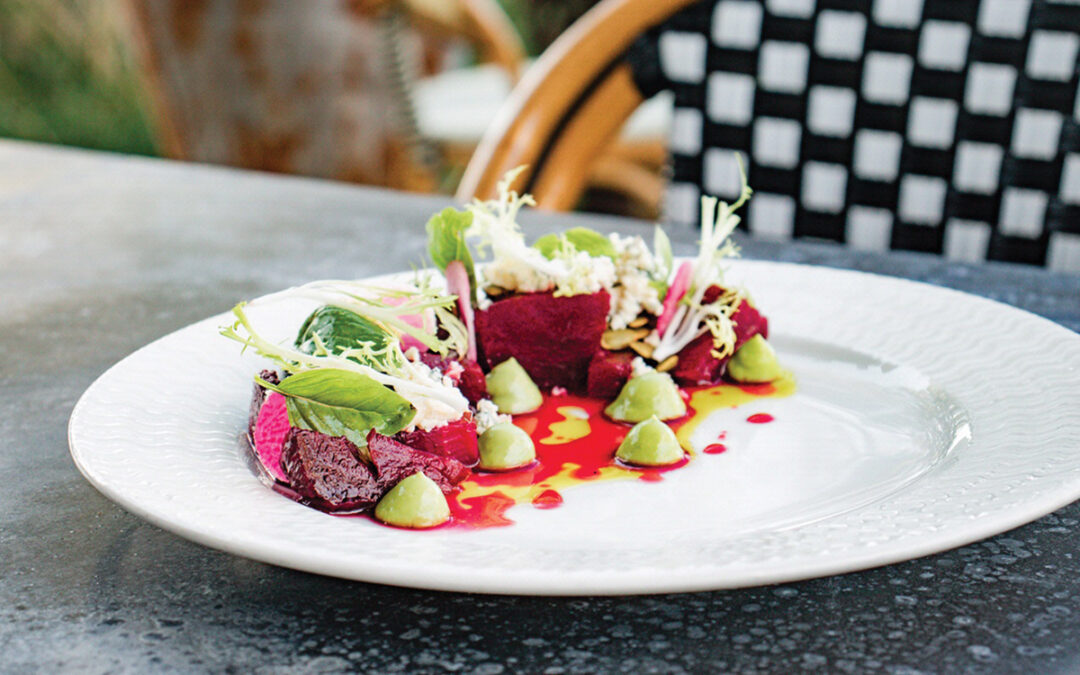Once in a while artist Constance “Connie” Lowe takes a break from her own work to assume the curatorial role. Such was the case recently when she agreed to serve as curator for Magnetic Fields, a show opening March 10 as the Southwest School of Art’s contribution to Contemporary Art Month. It started with a suggestion to exhibit the paintings of Minneapolis-based, German-born artist Barbara Kreft. “I thought they should be seen down here,” says Lowe, who is also a professor at UTSA. “We need to see more paintings in San Antonio, especially by people from elsewhere. But Paula (Owen, SSA’s president) said, ‘Why don’t you curate a group exhibition?’ So I had to find other artists whose work would be compatible with Barbara’s.”
The result is the current show that, besides Kreft, features San Antonian Richard Martinez, Dallasite Kim Cadmus Owens and Austinite Dan Sutherland. They represent two distinct approaches, says Lowe. While Kreft and Martinez gravitate toward orderly abstract patterns and an emphasis on surface, in the paintings of the other two, there are many recognizable elements intersecting with abstract shapes, as well as a sense of deep and layered space. “Painters set painting problems for themselves to investigate,” explains the professor. For instance, Owens is interested in exploring how to “integrate often overlooked, on-the-fringe industrial spaces with elements that show the painter’s mind at work.” Sutherland, on the other hand, begins with still life or landscape images and then proceeds to apply his “abstract interruptions and interventions.” Since we are having this conversation in January, Lowe has brought her computer to the Ruiz-Healy Gallery, which markets her own work, to show images of the four artists’ paintings. As we look at the pictures, I am most struck by Sutherland’s “interventions.” With just a hint of what may have served as a seed of inspiration, his paintings literally compel the viewer — at least this viewer — to take a closer look at his imaginatively surrealistic details, often rendered in bursts of riotous shapes and colors. For instance, the stunning oil (on aluminum base) titled Mortal Elemental features what appears to be a human skull in the process of decomposing into dozens of vivid elements that tumble over each other and eventually spread away into wing-reminiscent, multicolored fields. The juxtaposition of death and beauty, or perhaps death and renewal, though slightly disturbing, is also visually and emotionally satisfying. In sharp contrast, Martinez’s shaped-format canvases are large, cool and calm. They keep their own counsel, simply offering their mostly monochromatic faces to the viewer to admire for their subtle qualities. Analogous differences also exist between Kreft and Owens.
The way Lowe chose the artists for Magnetic Fields reflects her scholarly interests in contemporary paintings, says SSA’s Paula Owen: “Curators have to be scholars because they can’t just assemble pieces that represent their personal taste. There has to be a theoretical rationale for the exhibit, and that rationale comes from her research as a scholar. I greatly admire Connie as an intellectual.”
Exploring the “In-between-ness”
That intellectual penchant is apparent in Lowe’s own art. Two of her delicate and enigmatic pieces hang on the wall just behind us in the downstairs room of the gallery where we are conducting the interview. To those who follow contemporary art in San Antonio, these would immediately be recognizable as Lowe’s creations. The images consist of single, complex but symmetrical shapes that are vaguely biomorphic and evocative of familiar natural elements without being anything that you can actually name. Amplifying the impression of both something natural and something decorated by the human hand are the tight and vibrant color patterns that fill the entire shape, itself positioned against a white or other monochromatic background. “The human brain is accustomed to try to identify what it sees, but I don’t want the viewer to play the guessing game,” says the artist. “I give my images attributes and forms of medical imaging or biological specimens, things that we study and analyze, but these images don’t allow you to draw any conclusions from your study.”
Because of the uncertainty that the viewer experiences while looking at her drawings, in her artist’s statement Lowe says “this imaginative space between abstraction and representation, the psyche and the external world, drawing and object, makes visible a condition in which clear identification or categorization is evaded, making room for something else entirely to occur and take on its own life.” Intellectual formulations aside, the images are visually exciting and even amusing. They are also labor intensive. If they remind viewers of Rorschach test inkblots, that’s because they, too, start with inkblots. After tracing a somewhat modified inkblot on tracing paper, Lowe usually enlarges the resulting shape, covers it with translucent drafting film and draws with colored pencils on both sides of the film. Thus, what the viewer sees is a sort of double image, where the back serves as “under painting” for the front. As for the colors she chooses, she offers no explanation beyond this: “I can’t tell you why the colors are the way they are. They just work.”
Lately, Lowe has also started using computer programs to obtain more “irrational” color choices, which she then retranslates by hand, using either pencils or paints. Though she is best known for her Rorschach-type drawings, the artist has used other forms and materials as well, such as wool felt to create a series of similarly ambiguous wall-mounted soft “sculptures” and occasional multi-media installations. Lowe’s career took off after she moved here from Minneapolis in 1991 to join the UTSA art faculty. Her work has been shown in galleries and museums all over Texas and beyond, in many group shows and 12 solo exhibits. The latter include venues such as SSA and Artpace, as well as the Phoenix Art Museum, the Minneapolis Institute of Art and the Galveston Art Center. In 2010, she was featured in the San Antonio Museum of Art’s memorable Psychedelic: Optical and Visionary Art Since the 1960s, which was reviewed by ARTnews. Of the three images used to illustrate the article, one was of Lowe’s “specimen” painting. Though she was less successful on the sales front, she is now represented by dealer Patricia Ruiz-Healy.
“Connie brings to the table a new idiom, another language. I love her sense of color and composition,” says Ruiz-Healy, who deals mostly with internationally known Latin American artists. “In April, I’ll be taking her work to the Dallas Art Fair, where it will be seen by a wider audience and art experts. Many prominent galleries are invited to participate, and we are one of the few from Texas. And yes, definitely, I expect to sell as well.”
Before parting, we ask Lowe if she ever discusses with her students the role of contemporary art in society. That takes her a bit by surprise. “I don’t think much about that,” she admits. “What I discuss with students is what they need to know about what’s available to them in terms of a support structure, such things as grants and residencies, the gallery system, things I did not know about when I was a student.” But then, shifting somewhat the intention of the question, she adds, “There’s a dimension to being an artist that’s analogous to a (scientific) research dimension — an inquiry into the unknown and bringing into existence something that wasn’t there before.”









0 Comments